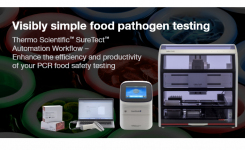STEC testing: complex and time-consuming
Fresh meat and vegetables have a short enough shelf-life as it is – and lengthy testing regimes for Shiga-toxin producing Escherichia coli (STEC) and other pathogens can limit that shelf-life further.
Detecting STEC may be of the utmost importance to both food safety and brand protection, but it can be incredibly complex.
The International Standards Organisation Technical Specification (ISO/TS) 13136:2012 details a real-time PCR-based method for the detection of STEC, and the determination of some of the top 5 dangerous serogroups: O157, O111, O26, O103, and O145.
The first step is an 18- to 24-hour enrichment process. The ISO standard, which is currently under revision, allows for a greater degree of flexibility in terms of the next stage for DNA extraction stipulating the use of an “appropriate nucleic acid extraction procedure for Gram-negative bacteria”, or commercial kits. The end-user laboratories must provide the evidence of the performances of the selected protocols in that respect, which could lead to extensive laboratory work.
Next, three simplex PCR mixes should be run to detect eae, stx1, and stx2 genes. If these are positive, five simplex PCR mixes are run for O157, O111, O26, O103, and O145 detection. A positive result here means 10 to 50 colonies must then be confirmed, necessitating a 24-hour purification step. It is also possible to perform multiplex PCR mixes and runs, which always requires optimization.
The process is challenging for a number of reasons, including how the lengthy enrichment step eats into the limited retail window of fresh beef and produce. In addition, in-house PCRs and purification are complex, making them both time and labour intensive.
An easier way
Thermo Fisher Scientific offer a simple PCR workflow for the rapid, accurate detection and identification of E. coli O157:H7 and other STEC serotypes (O26, O45, O103, O111, O121, O145) from food samples with results available in as little as 8 hours.
The Thermo Scientific™ SureTect™ O157:H7 and STEC Screening and Identification PCR Assays have been validated according to ISO 16140-2:2016 by AFNOR Certification for 375 g all meat (except poultry) and 375 g vegetables (including 25 g sprouts) and can be run without the need for Immunomagnetic Separation (IMS).
The collaborative study, part of AFNOR Certification body validation process, benchmarked the SureTect PCR Assay method against the ISO/TS 13136:2012 reference method to ensure it was as effective as the recognised gold standard. Successful completion of the comparison study led to the SureTect PCR Assay method being granted ISO 16140-2 certification. The work, which involved 16 collaborators from 12 laboratories, compared the efficacy of the methods on 25 g of ground beef.
This matrix was chosen due to its high-risk nature. Researchers found the SureTect PCR Assay method performed better than the reference ISO method, significantly reducing the time to a negative result – from 24 hours with ISO/TS 13136 to fewer than 10 hours with the SureTect PCR Assay method. For food producers, this means safe products can be sent to market sooner, conserving that all-important shelf-life without compromising on safety.
In addition, combining the detection of the STEC targets into two multiplex PCR assays, rather than running multiple simplex tests, reduced the complexity of the test workflow, especially as all the required quality controls are included in the kit. The harmonized enrichment protocol also enables users to test for STEC and Salmonella from a single enrichment broth for some key matrices, helping to keep costs down and minimize the space needed on the bench and in incubators. The work also validated the testing of large samples, of up to 375 g, for meat and meat products excluding poultry and for fruit and vegetables.
Ultimately, the validated workflow can help organizations to maximize the retail window of short shelf-life products, such as fresh beef and produce, without compromising on customer safety or risking the reputation of manufacturers or retailer brands.
Achieve rapid, accurate pathogen test results for a broad range of food, ingredients and environmental samples, including dairy, meat & poultry, seafood, produce, infant formula, chocolate samples, and more with our complete portfolio of SureTect PCR Assays, instruments, enrichment media and confirmation tests.
Available for detection of the following targets:
- Campylobacter jejuni, C. coli and C. lari (multiplex assay)
- Cronobacter species
- Escherichia coli O157:H7
- Escherichia coli O157:H7 and other STEC (2x multiplex assays)
- Listeria monocytogenes
- Listeria species
- Salmonella species
- Salmonella species, S. Typhimurium and S. Enteritidis (multiplex assay)
- Staphylococcus aureus
- Vibrio chlorae, V. parahaemolyticus and V. vulnificus (multiplex assay)
To find out more visit thermofisher.com/suretect or use the Request Information button to make direct contact with the supplier.























